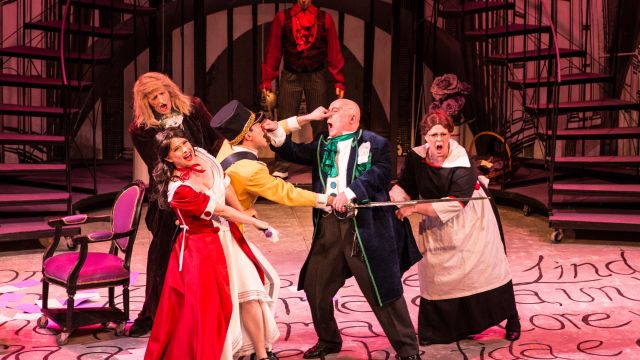The Barber of Seville
Melbourne Opera’s oft-revived production of ‘ The Barber of Seville’ retains a rather enviable freshness and vitality, in no small part due to the direction of Hugh Halliday, that all too rare director who can never bore an audience. By leaving the piece squarely ‘in period’ and essentially following the instructions left by composer Rossini, librettist Sterbini and playwright Beaumarchais, the audience was kept laughing from curtain-up to the final scene. Halliday’s first brilliant touch is to leave the curtain down for the overture. In an age when directors insist upon inventing stage action from the second the music starts, this is an all-too-rare luxury for an audience.
The well-rehearsed performers moved seamlessly around Anna Cordingley’s ingenious single-set and delicious use was made of a number of visual anachronisms including an iPod and headphones for Rosina and a zimmer frame (replete with bike lock) for Don Basilio. In the pit Maestro Greg Hocking kept the evening moving at a rollicking pace, with the all-male chorus only occasionally lagging behind. Great fun was had with the score, but never disrespectfully. Special mention must be made of the nimble continuo section, with Rossini’s recitatives nicely underscored with everything from Bizet’s ‘Toreador Song’ to the James Bond Theme, and the handful of bars from Stravinsky’s ‘Rite of Spring’ inserted into act II brought forth laughter from 20th Century Music-fans scattered throughout the Athenaeum Theatre.
In the age of The Newcomer it was marvellous to see a cast so beautifully balanced between seasoned and emerging artists, led by Roger Howell in a masterful interpretation of Doctor Bartolo, his fiendish patter aria neatly dispatched without apparent effort. Up-and-coming tenor Brenton Spiteri (soon to join the prestigious Young Artist Studio at the Opéra National de Lyon) sailed through Almaviva’s high tessitura and florid passagework with ease, delivering the often-cut ‘Cessa di piu resistere’ with voice to spare. Known as much for her Baroque virtuosity as for her Bel Canto interpretations, Sally-Anne Russell’s fleet coloratura and comic timing make her an ideal Rosina, nicely playing off the Figaro of Phillip Calcagno who made easy work of the famous ‘Largo al Factotum’. Soprano Jodie DeBono all but stole the show with her knock-out rendition of Berta’s ‘Il vecchietto cerca moglie’, one of opera’s great ’11 o’clock numbers’. If one had to have a quibble in the cast it is with David Gould’s occasional inaudibility during Don Basilio’s Act I aria, although his use of text and tremendous presence onstage is undeniable.
By performing the piece in English with small forces in a relatively small space, the audience is able to understand almost every word sung, a rare pleasure in any opera but more so in so plot-driven a farce such as this. Worth seeing even if you’ve seen this production before, and if you know someone who hasn't been to the opera before then take them along. It’s productions like this which create new audiences for opera.
Samuel Krum
Image: David Gould (Don Basilio), Sally-Anne Russell (Rosina), Brenton Spiteri (Count Almaviva), Phillip Calcagno (Figaro), Roger Howell (Dr Bartolo) and Jodie Debono (Berta).
Subscribe to our E-Newsletter, buy our latest print edition or find a Performing Arts book at Book Nook.

